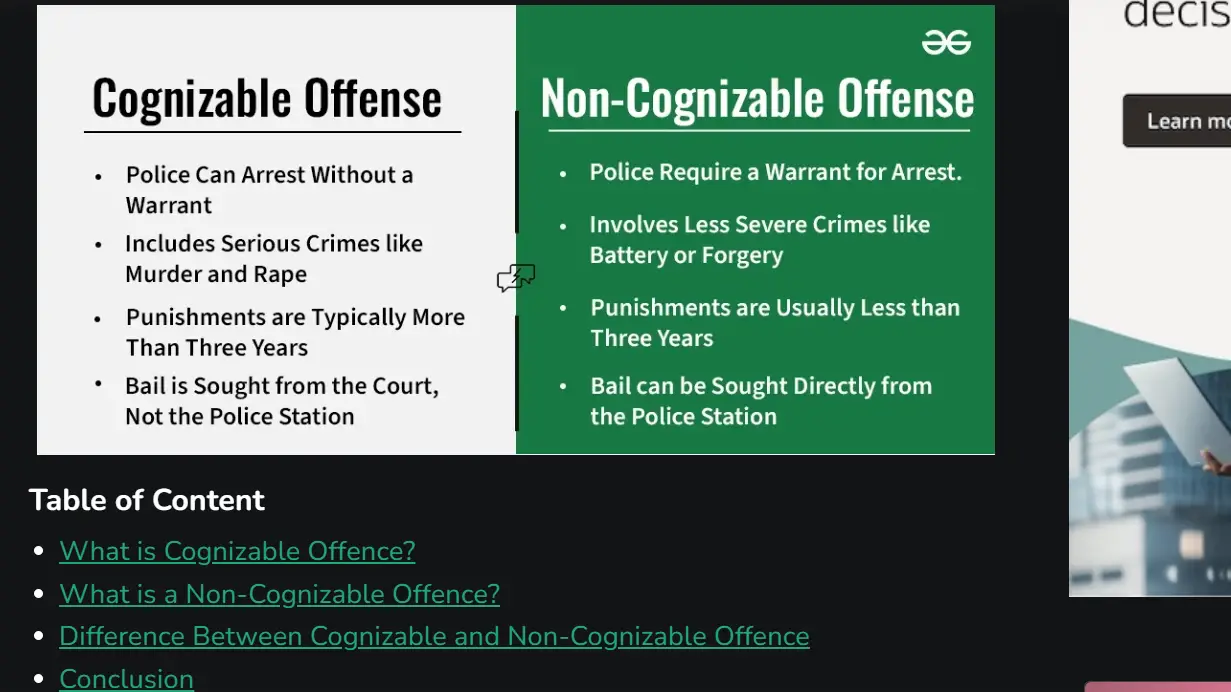
In the realm of law and criminal justice, understanding the nature of crimes is crucial for both law enforcement and the public. Two common classifications of offences in many legal systems are cognizable and non cognizable offences. While these terms may seem like legal jargon, they represent important distinctions that impact how crimes are reported, investigated, and prosecuted.
Table of Contents
What is a Cognizable Offence?
A cognizable offence is a type of crime for which a police officer has the authority to arrest the accused without a warrant and begin an investigation without the permission of a court. The seriousness of cognizable offences often involves harm or threat to public safety, property, or personal rights.
Examples of Cognizable Offences:
- Murder (Section 302, IPC)
- Rape (Section 376, IPC)
- Robbery (Section 392, IPC)
- Kidnapping (Section 363, IPC)
- Theft (Section 378, IPC)
These offences are deemed significant due to the potential harm they can cause to individuals or society as a whole, which is why the law grants police officers more powers to deal with them promptly.

P.C. -geeksforgeeks.org
Key Features of Cognizable Offences:
- Arrest without a warrant: Police can arrest the accused without prior permission from a magistrate.
- Immediate Investigation: Law enforcement can begin an investigation without needing court approval.
- Seriousness: Typically involves serious crimes that threaten public safety or order.
- Examples: As mentioned, crimes such as murder, rape, and robbery are cognizable.
What is a Non-Cognizable Offence?
In contrast, a non-cognizable offence is a crime where a police officer does not have the authority to arrest the accused without a warrant, nor can they start an investigation without the permission of a magistrate. Non-cognizable offences are generally considered less severe in nature compared to cognizable offences, often involving minor harm or violations.
Examples of Non-Cognizable Offences:
- Defamation (Section 499, IPC)
- Simple Assault (Section 352, IPC)
- Public Nuisance (Section 268, IPC)
- Minor theft (petty theft)
- Cheating (under certain circumstances, Section 420, IPC)
Key Features of Non-Cognizable Offences:
- Arrest only with a warrant: Police must obtain permission from a magistrate to arrest the accused.
- Investigation with court’s permission: Police cannot initiate an investigation without the magistrate’s order.
- Lesser severity: These crimes are usually considered to have a smaller impact on public safety.
- Examples: Minor assault, defamation, or petty theft are non-cognizable.
Difference Between Cognizable and Non Cognizable Offence
The primary distinction between cognizable and non-cognizable offences lies in the authority granted to law enforcement officers to take immediate action. Here’s a deeper dive into their differences:
| Criteria | Cognizable Offence | Non-Cognizable Offence |
|---|---|---|
| Police Authority | Police can arrest without a warrant. | Police cannot arrest without a warrant. |
| Investigation | Police can investigate without the magistrate’s approval. | Police can only investigate with the permission of a magistrate. |
| Nature of Offence | Generally serious offences that pose a threat to public safety. | Less severe, minor offences. |
| Examples | Murder, rape, robbery, kidnapping. | Defamation, minor assault, public nuisance. |
| Court Proceedings | These offences are typically triable in a Sessions Court. | These offences are typically triable in a Magistrate Court. |
Why Do These Classifications Matter?
The classification of offences into cognizable and non-cognizable categories serves several important functions in the legal system:
- Efficient Law Enforcement: Police can act quickly in the case of serious crimes (cognizable offences), whereas less urgent matters (non-cognizable offences) may require judicial oversight.
- Judicial Oversight: Non-cognizable offences require the involvement of a magistrate to ensure due process is followed before an investigation can begin.
- Public Safety: By prioritizing the investigation of cognizable offences, authorities ensure that threats to public safety are dealt with swiftly and effectively.
Legal Provisions and Framework in India
Under Indian law, the distinction between cognizable and non-cognizable offences is codified in the Indian Penal Code (IPC) and the Criminal Procedure Code (CrPC).
Indian Penal Code (IPC)
Sections of the IPC specifically outline which offences are cognizable and which are non-cognizable. Offences like murder, rape, and robbery are defined as cognizable, and police are empowered to investigate them directly. Meanwhile, minor offences like defamation and minor assault are categorized as non-cognizable.
Criminal Procedure Code (CrPC)
Section 154 of the CrPC mandates that an FIR (First Information Report) can only be filed for cognizable offences. It also dictates that for non-cognizable offences, a police officer can record the information but cannot initiate an investigation unless authorized by a magistrate.
How Does an FIR Work for Cognizable and Non Cognizable Offences?
- Cognizable Offence (Section 154 CrPC): The police are required to register an FIR (First Information Report) if the offence is cognizable. They can begin the investigation right away.
- Non-Cognizable Offence (Section 155 CrPC): In the case of a non-cognizable offence, the police will only record the information but cannot start an investigation without permission from the magistrate. In this case, the complainant is often advised to approach the court directly.
The Importance of This Distinction
The classification of crimes into cognizable and non cognizable is critical for a few reasons:
- Ensuring Proper Legal Procedure: By distinguishing between serious and minor offences, the law ensures that the legal process is efficient and appropriately applied based on the nature of the crime.
- Balancing Rights and Public Safety: The law gives police the authority to intervene in serious situations while preventing unnecessary interventions in less critical matters.
- Judicial Oversight in Minor Crimes: Non-cognizable offences involve judicial oversight to ensure that the law is applied fairly and justly in less severe cases.
Frequently Asked Questions (FAQs)
1. Can a cognizable offence be converted into a non-cognizable one?
No, cognizable offences remain as such, given their seriousness. A non-cognizable offence is not reclassified from a cognizable one under normal circumstances.
2. What happens if a non-cognizable offence is not investigated?
If police fail to investigate a non-cognizable offence, the complainant can seek the permission of a magistrate to proceed with an investigation.
3. Are police required to take action for non-cognizable offences?
Police are required to register the complaint but cannot proceed with an investigation without court approval for non-cognizable offences.
4. How do police determine if an offence is cognizable or non-cognizable?
The police determine the severity of the offence based on its nature, and the law outlines which crimes fall under each category.
5. Is bail granted in cognizable offences?
In cognizable offences, bail is granted according to the severity of the crime, but serious crimes like murder often result in non-bailable offences.
6. What is an example of a non-cognizable offence?
Minor theft, public nuisance, or defamation are examples of non-cognizable offences.
7. Can an FIR be filed for a non-cognizable offence?
Yes, but the police cannot begin an investigation without the magistrate’s approval.
8. How are cognizable offences tried in court?
Cognizable offences are generally tried in the Sessions Court, which deals with more serious crimes.
9. What happens after an FIR for a cognizable offence is filed?
After an FIR is filed for a cognizable offence, police begin their investigation, which can lead to the arrest of the accused.
10. Can a person be arrested for a non-cognizable offence?
A person cannot be arrested for a non-cognizable offence without a warrant from a magistrate.
Conclusion
Understanding the difference between cognizable and non cognizable offences is critical to navigating the legal system and ensuring proper law enforcement. These classifications directly affect how crimes are investigated, the powers of police, and the rights of the accused. Whether dealing with a serious crime or a minor violation, this distinction guides the entire criminal justice process.
For further reference, consult legal frameworks like the Indian Penal Code (IPC) and Criminal Procedure Code (CrPC), and always remember to stay informed on the latest legal provisions to understand your rights and responsibilities.
Sources and References:
- Indian Penal Code, 1860 – Official website of the Government of India
- Criminal Procedure Code, 1973
- Testbook.com
- iPleaders Blog
Also Read: Understanding Void Agreements: A Detailed Guide on Legal Implications and Case Laws
Also visit: Online Legal Service, Virtual Advice and Consultation
Also Read: Sources of Muslim Law: A Complete Guide



